Impact of Learning Organization on MBA's Business Performance
VerifiedAdded on 2021/02/17
|14
|4433
|21
Report
AI Summary
This report examines the critical need for a learning organization within the context of an MBA, focusing on how it can drive business efficiency and competitive advantage. The analysis delves into the core components of a learning organization, including operations, leadership, information systems, and finance, highlighting their interdependencies and impact on overall performance. The report emphasizes the benefits of system thinking, employee empowerment, and strategic adaptation to market changes. It also explores non-financial outcomes and the importance of benchmarking for continuous improvement. The study provides recommendations for enhancing MBA's operational activities and achieving long-term success through the adoption of a learning organization model. The report also emphasizes on the importance of adapting to change and continuous learning to gain a competitive advantage, and it analyzes the need for integrating various organizational functions like operations, leadership, information systems, and finance to maximize efficiency.

MATCH BOX ARCHITECTS
DESIGN PARTNERSHIP
DESIGN PARTNERSHIP
Paraphrase This Document
Need a fresh take? Get an instant paraphrase of this document with our AI Paraphraser
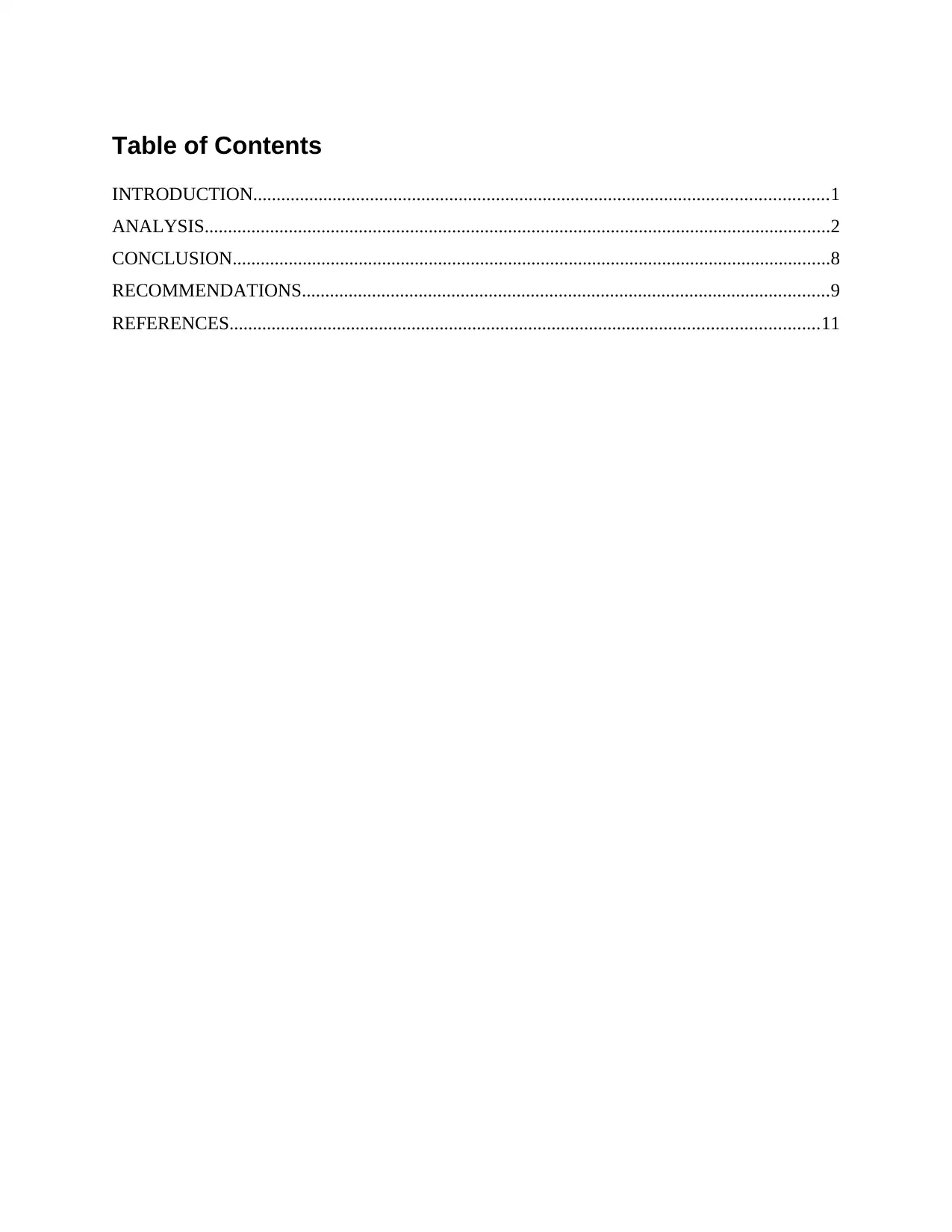
Table of Contents
INTRODUCTION...........................................................................................................................1
ANALYSIS......................................................................................................................................2
CONCLUSION................................................................................................................................8
RECOMMENDATIONS.................................................................................................................9
REFERENCES..............................................................................................................................11
INTRODUCTION...........................................................................................................................1
ANALYSIS......................................................................................................................................2
CONCLUSION................................................................................................................................8
RECOMMENDATIONS.................................................................................................................9
REFERENCES..............................................................................................................................11
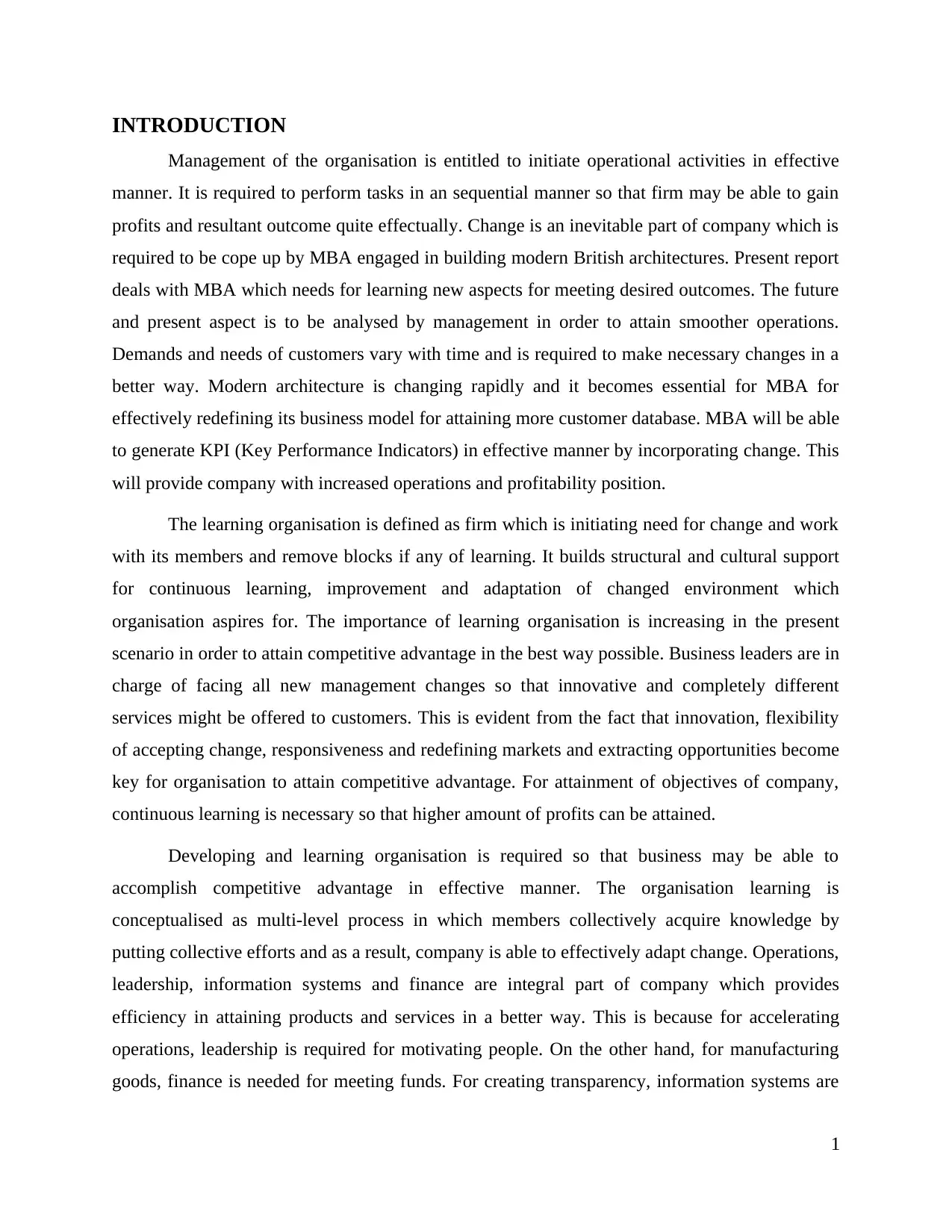
INTRODUCTION
Management of the organisation is entitled to initiate operational activities in effective
manner. It is required to perform tasks in an sequential manner so that firm may be able to gain
profits and resultant outcome quite effectually. Change is an inevitable part of company which is
required to be cope up by MBA engaged in building modern British architectures. Present report
deals with MBA which needs for learning new aspects for meeting desired outcomes. The future
and present aspect is to be analysed by management in order to attain smoother operations.
Demands and needs of customers vary with time and is required to make necessary changes in a
better way. Modern architecture is changing rapidly and it becomes essential for MBA for
effectively redefining its business model for attaining more customer database. MBA will be able
to generate KPI (Key Performance Indicators) in effective manner by incorporating change. This
will provide company with increased operations and profitability position.
The learning organisation is defined as firm which is initiating need for change and work
with its members and remove blocks if any of learning. It builds structural and cultural support
for continuous learning, improvement and adaptation of changed environment which
organisation aspires for. The importance of learning organisation is increasing in the present
scenario in order to attain competitive advantage in the best way possible. Business leaders are in
charge of facing all new management changes so that innovative and completely different
services might be offered to customers. This is evident from the fact that innovation, flexibility
of accepting change, responsiveness and redefining markets and extracting opportunities become
key for organisation to attain competitive advantage. For attainment of objectives of company,
continuous learning is necessary so that higher amount of profits can be attained.
Developing and learning organisation is required so that business may be able to
accomplish competitive advantage in effective manner. The organisation learning is
conceptualised as multi-level process in which members collectively acquire knowledge by
putting collective efforts and as a result, company is able to effectively adapt change. Operations,
leadership, information systems and finance are integral part of company which provides
efficiency in attaining products and services in a better way. This is because for accelerating
operations, leadership is required for motivating people. On the other hand, for manufacturing
goods, finance is needed for meeting funds. For creating transparency, information systems are
1
Management of the organisation is entitled to initiate operational activities in effective
manner. It is required to perform tasks in an sequential manner so that firm may be able to gain
profits and resultant outcome quite effectually. Change is an inevitable part of company which is
required to be cope up by MBA engaged in building modern British architectures. Present report
deals with MBA which needs for learning new aspects for meeting desired outcomes. The future
and present aspect is to be analysed by management in order to attain smoother operations.
Demands and needs of customers vary with time and is required to make necessary changes in a
better way. Modern architecture is changing rapidly and it becomes essential for MBA for
effectively redefining its business model for attaining more customer database. MBA will be able
to generate KPI (Key Performance Indicators) in effective manner by incorporating change. This
will provide company with increased operations and profitability position.
The learning organisation is defined as firm which is initiating need for change and work
with its members and remove blocks if any of learning. It builds structural and cultural support
for continuous learning, improvement and adaptation of changed environment which
organisation aspires for. The importance of learning organisation is increasing in the present
scenario in order to attain competitive advantage in the best way possible. Business leaders are in
charge of facing all new management changes so that innovative and completely different
services might be offered to customers. This is evident from the fact that innovation, flexibility
of accepting change, responsiveness and redefining markets and extracting opportunities become
key for organisation to attain competitive advantage. For attainment of objectives of company,
continuous learning is necessary so that higher amount of profits can be attained.
Developing and learning organisation is required so that business may be able to
accomplish competitive advantage in effective manner. The organisation learning is
conceptualised as multi-level process in which members collectively acquire knowledge by
putting collective efforts and as a result, company is able to effectively adapt change. Operations,
leadership, information systems and finance are integral part of company which provides
efficiency in attaining products and services in a better way. This is because for accelerating
operations, leadership is required for motivating people. On the other hand, for manufacturing
goods, finance is needed for meeting funds. For creating transparency, information systems are
1
⊘ This is a preview!⊘
Do you want full access?
Subscribe today to unlock all pages.

Trusted by 1+ million students worldwide
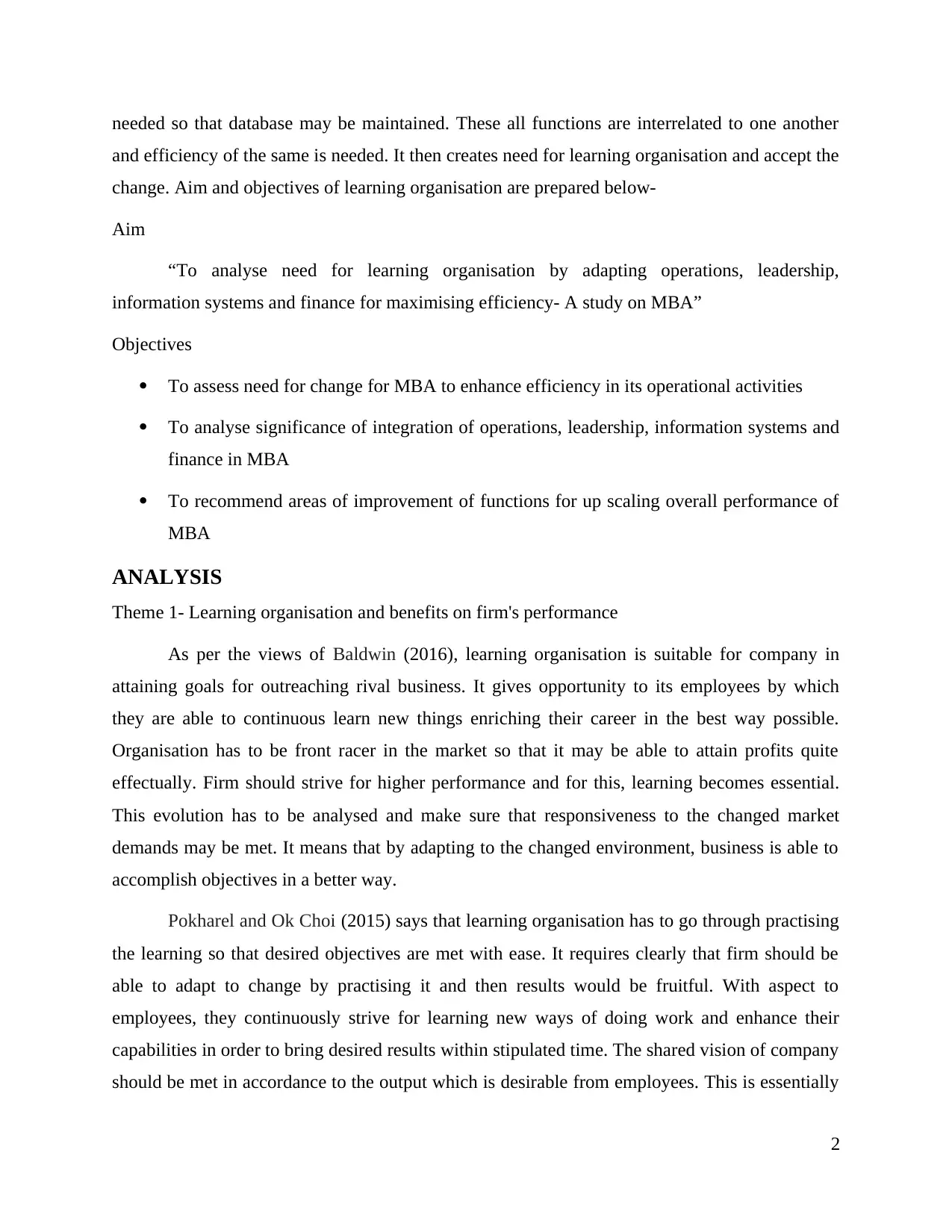
needed so that database may be maintained. These all functions are interrelated to one another
and efficiency of the same is needed. It then creates need for learning organisation and accept the
change. Aim and objectives of learning organisation are prepared below-
Aim
“To analyse need for learning organisation by adapting operations, leadership,
information systems and finance for maximising efficiency- A study on MBA”
Objectives
To assess need for change for MBA to enhance efficiency in its operational activities
To analyse significance of integration of operations, leadership, information systems and
finance in MBA
To recommend areas of improvement of functions for up scaling overall performance of
MBA
ANALYSIS
Theme 1- Learning organisation and benefits on firm's performance
As per the views of Baldwin (2016), learning organisation is suitable for company in
attaining goals for outreaching rival business. It gives opportunity to its employees by which
they are able to continuous learn new things enriching their career in the best way possible.
Organisation has to be front racer in the market so that it may be able to attain profits quite
effectually. Firm should strive for higher performance and for this, learning becomes essential.
This evolution has to be analysed and make sure that responsiveness to the changed market
demands may be met. It means that by adapting to the changed environment, business is able to
accomplish objectives in a better way.
Pokharel and Ok Choi (2015) says that learning organisation has to go through practising
the learning so that desired objectives are met with ease. It requires clearly that firm should be
able to adapt to change by practising it and then results would be fruitful. With aspect to
employees, they continuously strive for learning new ways of doing work and enhance their
capabilities in order to bring desired results within stipulated time. The shared vision of company
should be met in accordance to the output which is desirable from employees. This is essentially
2
and efficiency of the same is needed. It then creates need for learning organisation and accept the
change. Aim and objectives of learning organisation are prepared below-
Aim
“To analyse need for learning organisation by adapting operations, leadership,
information systems and finance for maximising efficiency- A study on MBA”
Objectives
To assess need for change for MBA to enhance efficiency in its operational activities
To analyse significance of integration of operations, leadership, information systems and
finance in MBA
To recommend areas of improvement of functions for up scaling overall performance of
MBA
ANALYSIS
Theme 1- Learning organisation and benefits on firm's performance
As per the views of Baldwin (2016), learning organisation is suitable for company in
attaining goals for outreaching rival business. It gives opportunity to its employees by which
they are able to continuous learn new things enriching their career in the best way possible.
Organisation has to be front racer in the market so that it may be able to attain profits quite
effectually. Firm should strive for higher performance and for this, learning becomes essential.
This evolution has to be analysed and make sure that responsiveness to the changed market
demands may be met. It means that by adapting to the changed environment, business is able to
accomplish objectives in a better way.
Pokharel and Ok Choi (2015) says that learning organisation has to go through practising
the learning so that desired objectives are met with ease. It requires clearly that firm should be
able to adapt to change by practising it and then results would be fruitful. With aspect to
employees, they continuously strive for learning new ways of doing work and enhance their
capabilities in order to bring desired results within stipulated time. The shared vision of company
should be met in accordance to the output which is desirable from employees. This is essentially
2
Paraphrase This Document
Need a fresh take? Get an instant paraphrase of this document with our AI Paraphraser
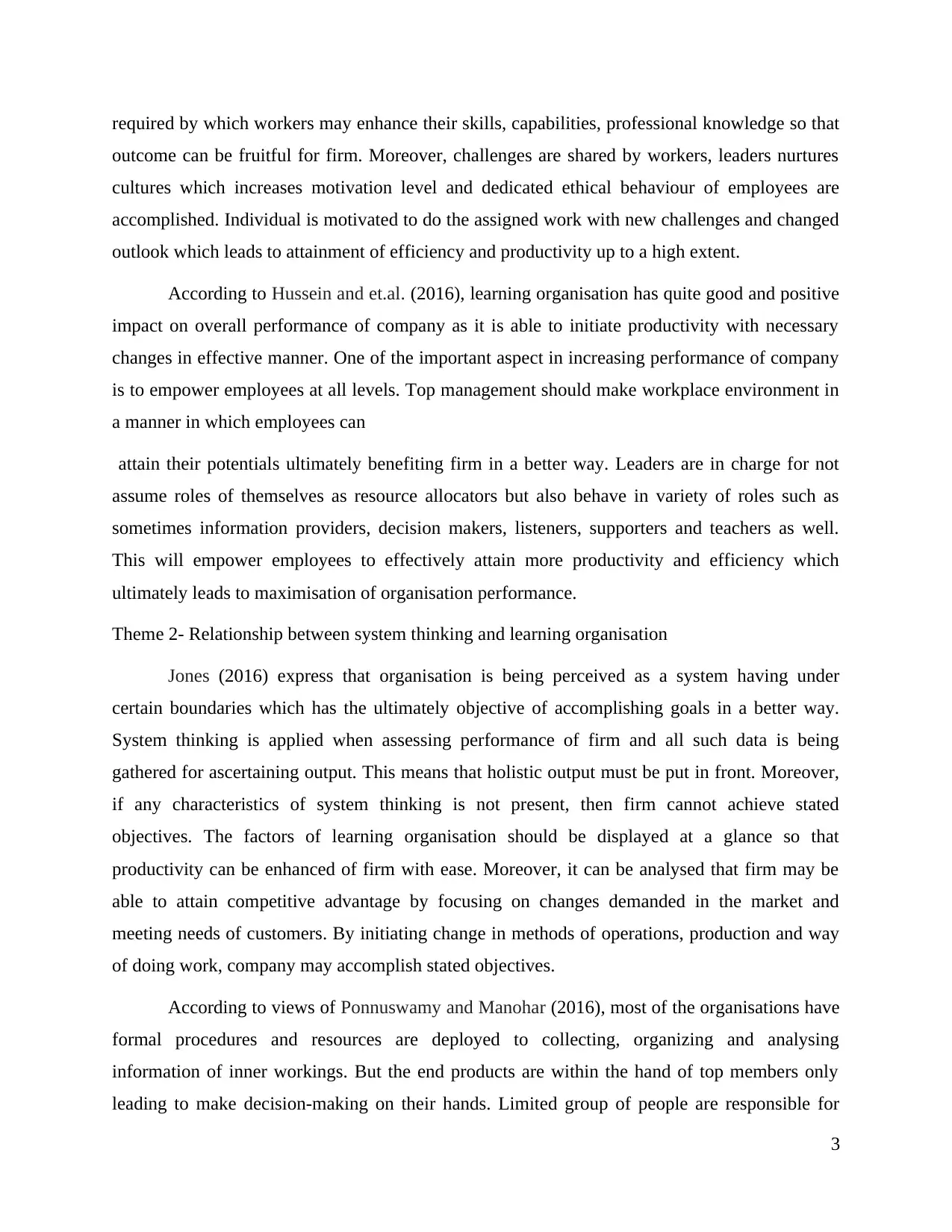
required by which workers may enhance their skills, capabilities, professional knowledge so that
outcome can be fruitful for firm. Moreover, challenges are shared by workers, leaders nurtures
cultures which increases motivation level and dedicated ethical behaviour of employees are
accomplished. Individual is motivated to do the assigned work with new challenges and changed
outlook which leads to attainment of efficiency and productivity up to a high extent.
According to Hussein and et.al. (2016), learning organisation has quite good and positive
impact on overall performance of company as it is able to initiate productivity with necessary
changes in effective manner. One of the important aspect in increasing performance of company
is to empower employees at all levels. Top management should make workplace environment in
a manner in which employees can
attain their potentials ultimately benefiting firm in a better way. Leaders are in charge for not
assume roles of themselves as resource allocators but also behave in variety of roles such as
sometimes information providers, decision makers, listeners, supporters and teachers as well.
This will empower employees to effectively attain more productivity and efficiency which
ultimately leads to maximisation of organisation performance.
Theme 2- Relationship between system thinking and learning organisation
Jones (2016) express that organisation is being perceived as a system having under
certain boundaries which has the ultimately objective of accomplishing goals in a better way.
System thinking is applied when assessing performance of firm and all such data is being
gathered for ascertaining output. This means that holistic output must be put in front. Moreover,
if any characteristics of system thinking is not present, then firm cannot achieve stated
objectives. The factors of learning organisation should be displayed at a glance so that
productivity can be enhanced of firm with ease. Moreover, it can be analysed that firm may be
able to attain competitive advantage by focusing on changes demanded in the market and
meeting needs of customers. By initiating change in methods of operations, production and way
of doing work, company may accomplish stated objectives.
According to views of Ponnuswamy and Manohar (2016), most of the organisations have
formal procedures and resources are deployed to collecting, organizing and analysing
information of inner workings. But the end products are within the hand of top members only
leading to make decision-making on their hands. Limited group of people are responsible for
3
outcome can be fruitful for firm. Moreover, challenges are shared by workers, leaders nurtures
cultures which increases motivation level and dedicated ethical behaviour of employees are
accomplished. Individual is motivated to do the assigned work with new challenges and changed
outlook which leads to attainment of efficiency and productivity up to a high extent.
According to Hussein and et.al. (2016), learning organisation has quite good and positive
impact on overall performance of company as it is able to initiate productivity with necessary
changes in effective manner. One of the important aspect in increasing performance of company
is to empower employees at all levels. Top management should make workplace environment in
a manner in which employees can
attain their potentials ultimately benefiting firm in a better way. Leaders are in charge for not
assume roles of themselves as resource allocators but also behave in variety of roles such as
sometimes information providers, decision makers, listeners, supporters and teachers as well.
This will empower employees to effectively attain more productivity and efficiency which
ultimately leads to maximisation of organisation performance.
Theme 2- Relationship between system thinking and learning organisation
Jones (2016) express that organisation is being perceived as a system having under
certain boundaries which has the ultimately objective of accomplishing goals in a better way.
System thinking is applied when assessing performance of firm and all such data is being
gathered for ascertaining output. This means that holistic output must be put in front. Moreover,
if any characteristics of system thinking is not present, then firm cannot achieve stated
objectives. The factors of learning organisation should be displayed at a glance so that
productivity can be enhanced of firm with ease. Moreover, it can be analysed that firm may be
able to attain competitive advantage by focusing on changes demanded in the market and
meeting needs of customers. By initiating change in methods of operations, production and way
of doing work, company may accomplish stated objectives.
According to views of Ponnuswamy and Manohar (2016), most of the organisations have
formal procedures and resources are deployed to collecting, organizing and analysing
information of inner workings. But the end products are within the hand of top members only
leading to make decision-making on their hands. Limited group of people are responsible for
3
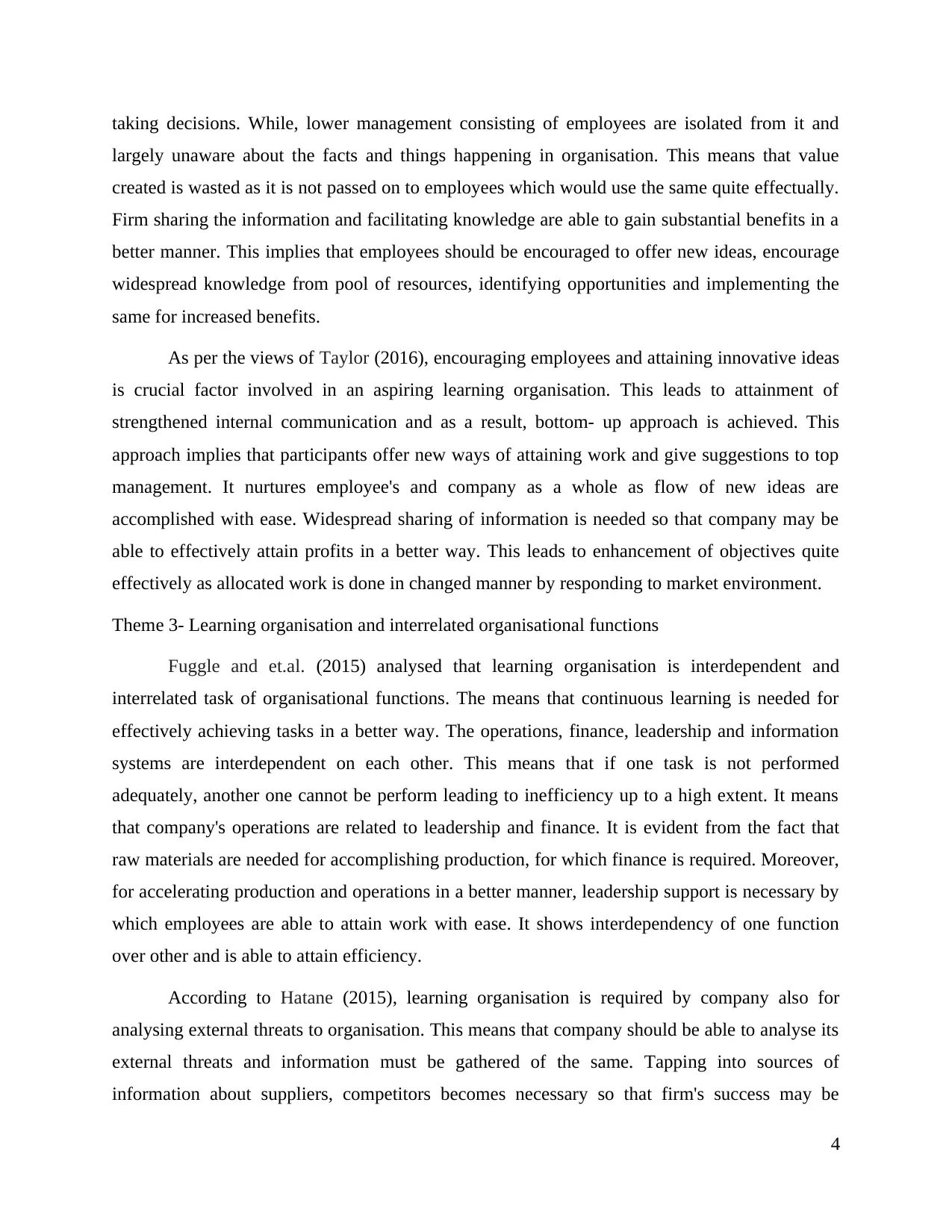
taking decisions. While, lower management consisting of employees are isolated from it and
largely unaware about the facts and things happening in organisation. This means that value
created is wasted as it is not passed on to employees which would use the same quite effectually.
Firm sharing the information and facilitating knowledge are able to gain substantial benefits in a
better manner. This implies that employees should be encouraged to offer new ideas, encourage
widespread knowledge from pool of resources, identifying opportunities and implementing the
same for increased benefits.
As per the views of Taylor (2016), encouraging employees and attaining innovative ideas
is crucial factor involved in an aspiring learning organisation. This leads to attainment of
strengthened internal communication and as a result, bottom- up approach is achieved. This
approach implies that participants offer new ways of attaining work and give suggestions to top
management. It nurtures employee's and company as a whole as flow of new ideas are
accomplished with ease. Widespread sharing of information is needed so that company may be
able to effectively attain profits in a better way. This leads to enhancement of objectives quite
effectively as allocated work is done in changed manner by responding to market environment.
Theme 3- Learning organisation and interrelated organisational functions
Fuggle and et.al. (2015) analysed that learning organisation is interdependent and
interrelated task of organisational functions. The means that continuous learning is needed for
effectively achieving tasks in a better way. The operations, finance, leadership and information
systems are interdependent on each other. This means that if one task is not performed
adequately, another one cannot be perform leading to inefficiency up to a high extent. It means
that company's operations are related to leadership and finance. It is evident from the fact that
raw materials are needed for accomplishing production, for which finance is required. Moreover,
for accelerating production and operations in a better manner, leadership support is necessary by
which employees are able to attain work with ease. It shows interdependency of one function
over other and is able to attain efficiency.
According to Hatane (2015), learning organisation is required by company also for
analysing external threats to organisation. This means that company should be able to analyse its
external threats and information must be gathered of the same. Tapping into sources of
information about suppliers, competitors becomes necessary so that firm's success may be
4
largely unaware about the facts and things happening in organisation. This means that value
created is wasted as it is not passed on to employees which would use the same quite effectually.
Firm sharing the information and facilitating knowledge are able to gain substantial benefits in a
better manner. This implies that employees should be encouraged to offer new ideas, encourage
widespread knowledge from pool of resources, identifying opportunities and implementing the
same for increased benefits.
As per the views of Taylor (2016), encouraging employees and attaining innovative ideas
is crucial factor involved in an aspiring learning organisation. This leads to attainment of
strengthened internal communication and as a result, bottom- up approach is achieved. This
approach implies that participants offer new ways of attaining work and give suggestions to top
management. It nurtures employee's and company as a whole as flow of new ideas are
accomplished with ease. Widespread sharing of information is needed so that company may be
able to effectively attain profits in a better way. This leads to enhancement of objectives quite
effectively as allocated work is done in changed manner by responding to market environment.
Theme 3- Learning organisation and interrelated organisational functions
Fuggle and et.al. (2015) analysed that learning organisation is interdependent and
interrelated task of organisational functions. The means that continuous learning is needed for
effectively achieving tasks in a better way. The operations, finance, leadership and information
systems are interdependent on each other. This means that if one task is not performed
adequately, another one cannot be perform leading to inefficiency up to a high extent. It means
that company's operations are related to leadership and finance. It is evident from the fact that
raw materials are needed for accomplishing production, for which finance is required. Moreover,
for accelerating production and operations in a better manner, leadership support is necessary by
which employees are able to attain work with ease. It shows interdependency of one function
over other and is able to attain efficiency.
According to Hatane (2015), learning organisation is required by company also for
analysing external threats to organisation. This means that company should be able to analyse its
external threats and information must be gathered of the same. Tapping into sources of
information about suppliers, competitors becomes necessary so that firm's success may be
4
⊘ This is a preview!⊘
Do you want full access?
Subscribe today to unlock all pages.

Trusted by 1+ million students worldwide
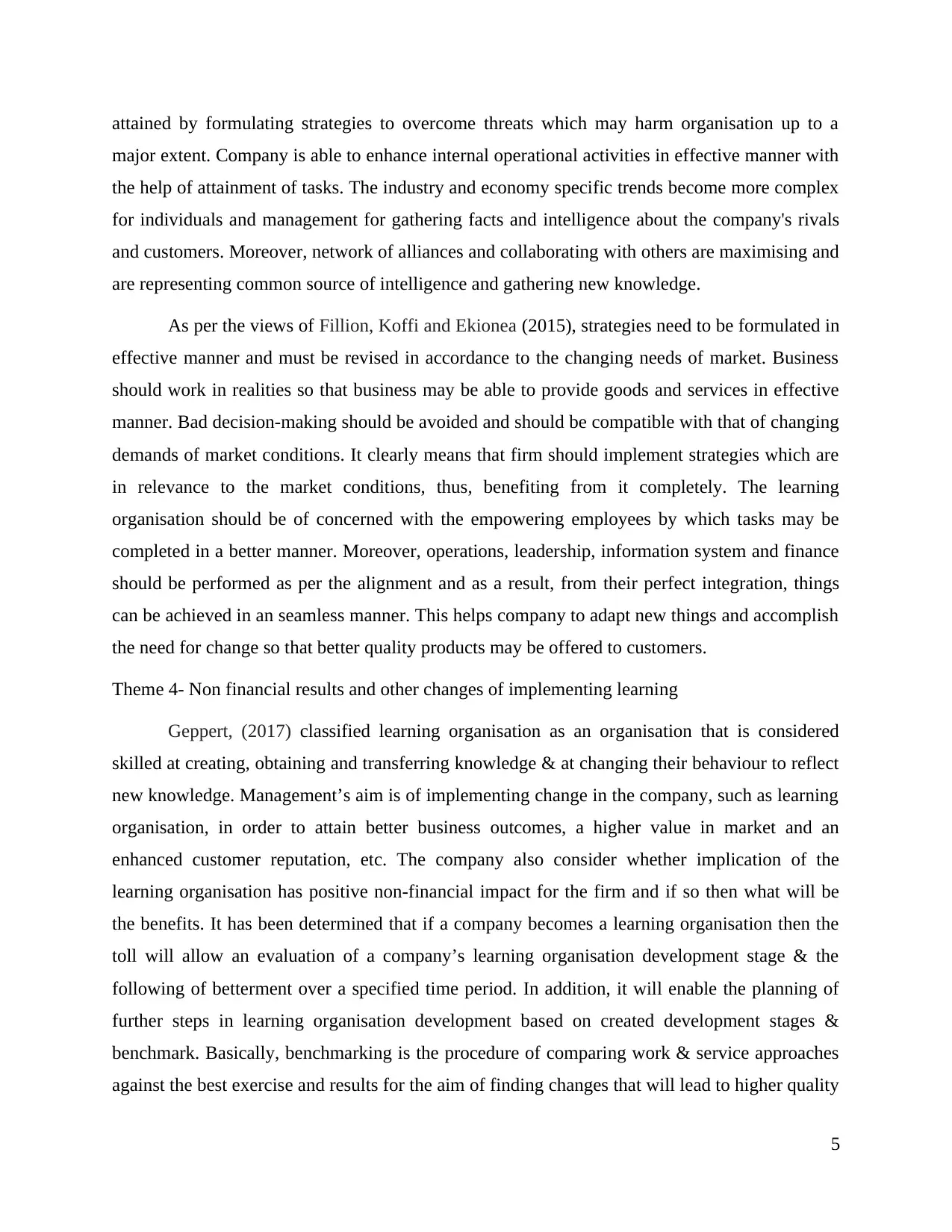
attained by formulating strategies to overcome threats which may harm organisation up to a
major extent. Company is able to enhance internal operational activities in effective manner with
the help of attainment of tasks. The industry and economy specific trends become more complex
for individuals and management for gathering facts and intelligence about the company's rivals
and customers. Moreover, network of alliances and collaborating with others are maximising and
are representing common source of intelligence and gathering new knowledge.
As per the views of Fillion, Koffi and Ekionea (2015), strategies need to be formulated in
effective manner and must be revised in accordance to the changing needs of market. Business
should work in realities so that business may be able to provide goods and services in effective
manner. Bad decision-making should be avoided and should be compatible with that of changing
demands of market conditions. It clearly means that firm should implement strategies which are
in relevance to the market conditions, thus, benefiting from it completely. The learning
organisation should be of concerned with the empowering employees by which tasks may be
completed in a better manner. Moreover, operations, leadership, information system and finance
should be performed as per the alignment and as a result, from their perfect integration, things
can be achieved in an seamless manner. This helps company to adapt new things and accomplish
the need for change so that better quality products may be offered to customers.
Theme 4- Non financial results and other changes of implementing learning
Geppert, (2017) classified learning organisation as an organisation that is considered
skilled at creating, obtaining and transferring knowledge & at changing their behaviour to reflect
new knowledge. Management’s aim is of implementing change in the company, such as learning
organisation, in order to attain better business outcomes, a higher value in market and an
enhanced customer reputation, etc. The company also consider whether implication of the
learning organisation has positive non-financial impact for the firm and if so then what will be
the benefits. It has been determined that if a company becomes a learning organisation then the
toll will allow an evaluation of a company’s learning organisation development stage & the
following of betterment over a specified time period. In addition, it will enable the planning of
further steps in learning organisation development based on created development stages &
benchmark. Basically, benchmarking is the procedure of comparing work & service approaches
against the best exercise and results for the aim of finding changes that will lead to higher quality
5
major extent. Company is able to enhance internal operational activities in effective manner with
the help of attainment of tasks. The industry and economy specific trends become more complex
for individuals and management for gathering facts and intelligence about the company's rivals
and customers. Moreover, network of alliances and collaborating with others are maximising and
are representing common source of intelligence and gathering new knowledge.
As per the views of Fillion, Koffi and Ekionea (2015), strategies need to be formulated in
effective manner and must be revised in accordance to the changing needs of market. Business
should work in realities so that business may be able to provide goods and services in effective
manner. Bad decision-making should be avoided and should be compatible with that of changing
demands of market conditions. It clearly means that firm should implement strategies which are
in relevance to the market conditions, thus, benefiting from it completely. The learning
organisation should be of concerned with the empowering employees by which tasks may be
completed in a better manner. Moreover, operations, leadership, information system and finance
should be performed as per the alignment and as a result, from their perfect integration, things
can be achieved in an seamless manner. This helps company to adapt new things and accomplish
the need for change so that better quality products may be offered to customers.
Theme 4- Non financial results and other changes of implementing learning
Geppert, (2017) classified learning organisation as an organisation that is considered
skilled at creating, obtaining and transferring knowledge & at changing their behaviour to reflect
new knowledge. Management’s aim is of implementing change in the company, such as learning
organisation, in order to attain better business outcomes, a higher value in market and an
enhanced customer reputation, etc. The company also consider whether implication of the
learning organisation has positive non-financial impact for the firm and if so then what will be
the benefits. It has been determined that if a company becomes a learning organisation then the
toll will allow an evaluation of a company’s learning organisation development stage & the
following of betterment over a specified time period. In addition, it will enable the planning of
further steps in learning organisation development based on created development stages &
benchmark. Basically, benchmarking is the procedure of comparing work & service approaches
against the best exercise and results for the aim of finding changes that will lead to higher quality
5
Paraphrase This Document
Need a fresh take? Get an instant paraphrase of this document with our AI Paraphraser
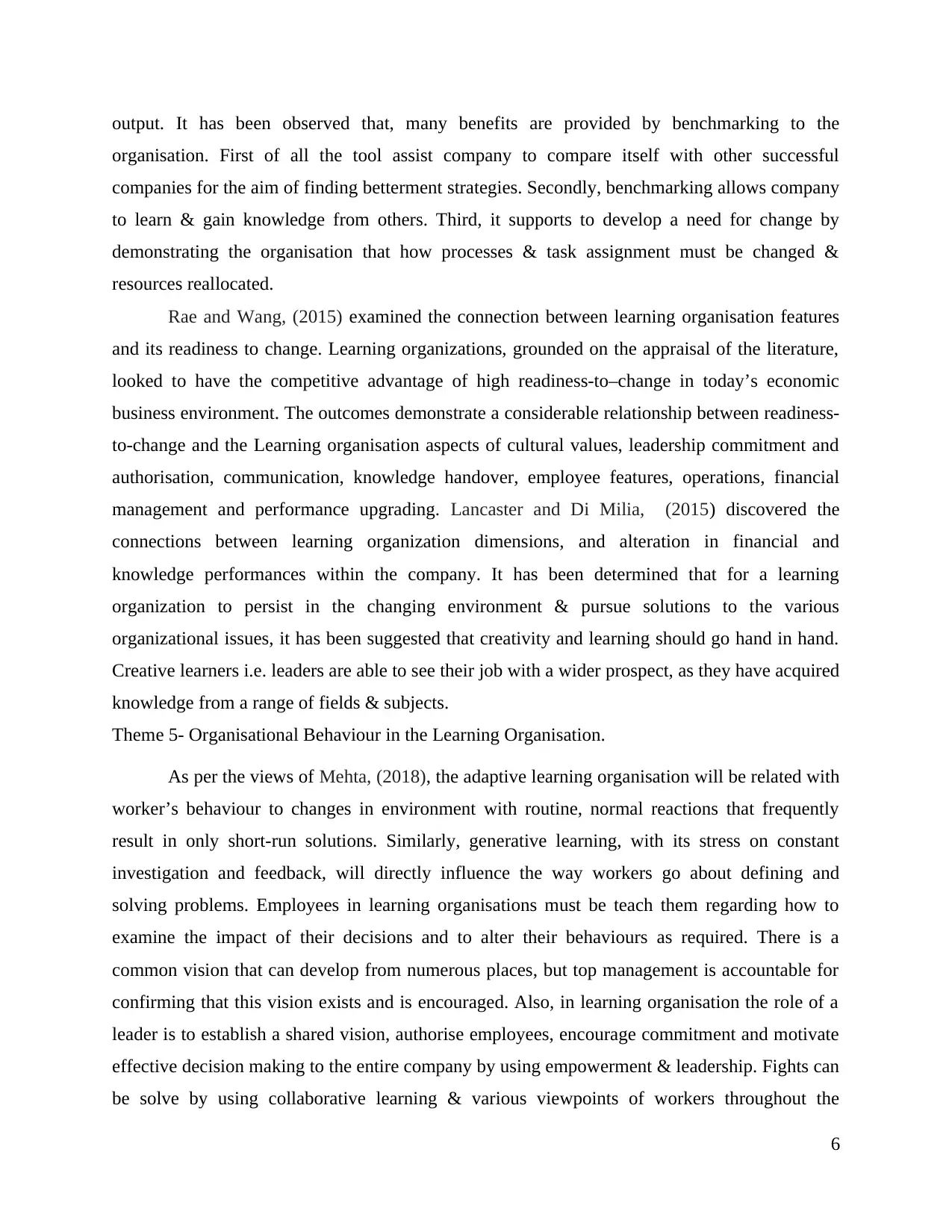
output. It has been observed that, many benefits are provided by benchmarking to the
organisation. First of all the tool assist company to compare itself with other successful
companies for the aim of finding betterment strategies. Secondly, benchmarking allows company
to learn & gain knowledge from others. Third, it supports to develop a need for change by
demonstrating the organisation that how processes & task assignment must be changed &
resources reallocated.
Rae and Wang, (2015) examined the connection between learning organisation features
and its readiness to change. Learning organizations, grounded on the appraisal of the literature,
looked to have the competitive advantage of high readiness-to–change in today’s economic
business environment. The outcomes demonstrate a considerable relationship between readiness-
to-change and the Learning organisation aspects of cultural values, leadership commitment and
authorisation, communication, knowledge handover, employee features, operations, financial
management and performance upgrading. Lancaster and Di Milia, (2015) discovered the
connections between learning organization dimensions, and alteration in financial and
knowledge performances within the company. It has been determined that for a learning
organization to persist in the changing environment & pursue solutions to the various
organizational issues, it has been suggested that creativity and learning should go hand in hand.
Creative learners i.e. leaders are able to see their job with a wider prospect, as they have acquired
knowledge from a range of fields & subjects.
Theme 5- Organisational Behaviour in the Learning Organisation.
As per the views of Mehta, (2018), the adaptive learning organisation will be related with
worker’s behaviour to changes in environment with routine, normal reactions that frequently
result in only short-run solutions. Similarly, generative learning, with its stress on constant
investigation and feedback, will directly influence the way workers go about defining and
solving problems. Employees in learning organisations must be teach them regarding how to
examine the impact of their decisions and to alter their behaviours as required. There is a
common vision that can develop from numerous places, but top management is accountable for
confirming that this vision exists and is encouraged. Also, in learning organisation the role of a
leader is to establish a shared vision, authorise employees, encourage commitment and motivate
effective decision making to the entire company by using empowerment & leadership. Fights can
be solve by using collaborative learning & various viewpoints of workers throughout the
6
organisation. First of all the tool assist company to compare itself with other successful
companies for the aim of finding betterment strategies. Secondly, benchmarking allows company
to learn & gain knowledge from others. Third, it supports to develop a need for change by
demonstrating the organisation that how processes & task assignment must be changed &
resources reallocated.
Rae and Wang, (2015) examined the connection between learning organisation features
and its readiness to change. Learning organizations, grounded on the appraisal of the literature,
looked to have the competitive advantage of high readiness-to–change in today’s economic
business environment. The outcomes demonstrate a considerable relationship between readiness-
to-change and the Learning organisation aspects of cultural values, leadership commitment and
authorisation, communication, knowledge handover, employee features, operations, financial
management and performance upgrading. Lancaster and Di Milia, (2015) discovered the
connections between learning organization dimensions, and alteration in financial and
knowledge performances within the company. It has been determined that for a learning
organization to persist in the changing environment & pursue solutions to the various
organizational issues, it has been suggested that creativity and learning should go hand in hand.
Creative learners i.e. leaders are able to see their job with a wider prospect, as they have acquired
knowledge from a range of fields & subjects.
Theme 5- Organisational Behaviour in the Learning Organisation.
As per the views of Mehta, (2018), the adaptive learning organisation will be related with
worker’s behaviour to changes in environment with routine, normal reactions that frequently
result in only short-run solutions. Similarly, generative learning, with its stress on constant
investigation and feedback, will directly influence the way workers go about defining and
solving problems. Employees in learning organisations must be teach them regarding how to
examine the impact of their decisions and to alter their behaviours as required. There is a
common vision that can develop from numerous places, but top management is accountable for
confirming that this vision exists and is encouraged. Also, in learning organisation the role of a
leader is to establish a shared vision, authorise employees, encourage commitment and motivate
effective decision making to the entire company by using empowerment & leadership. Fights can
be solve by using collaborative learning & various viewpoints of workers throughout the
6
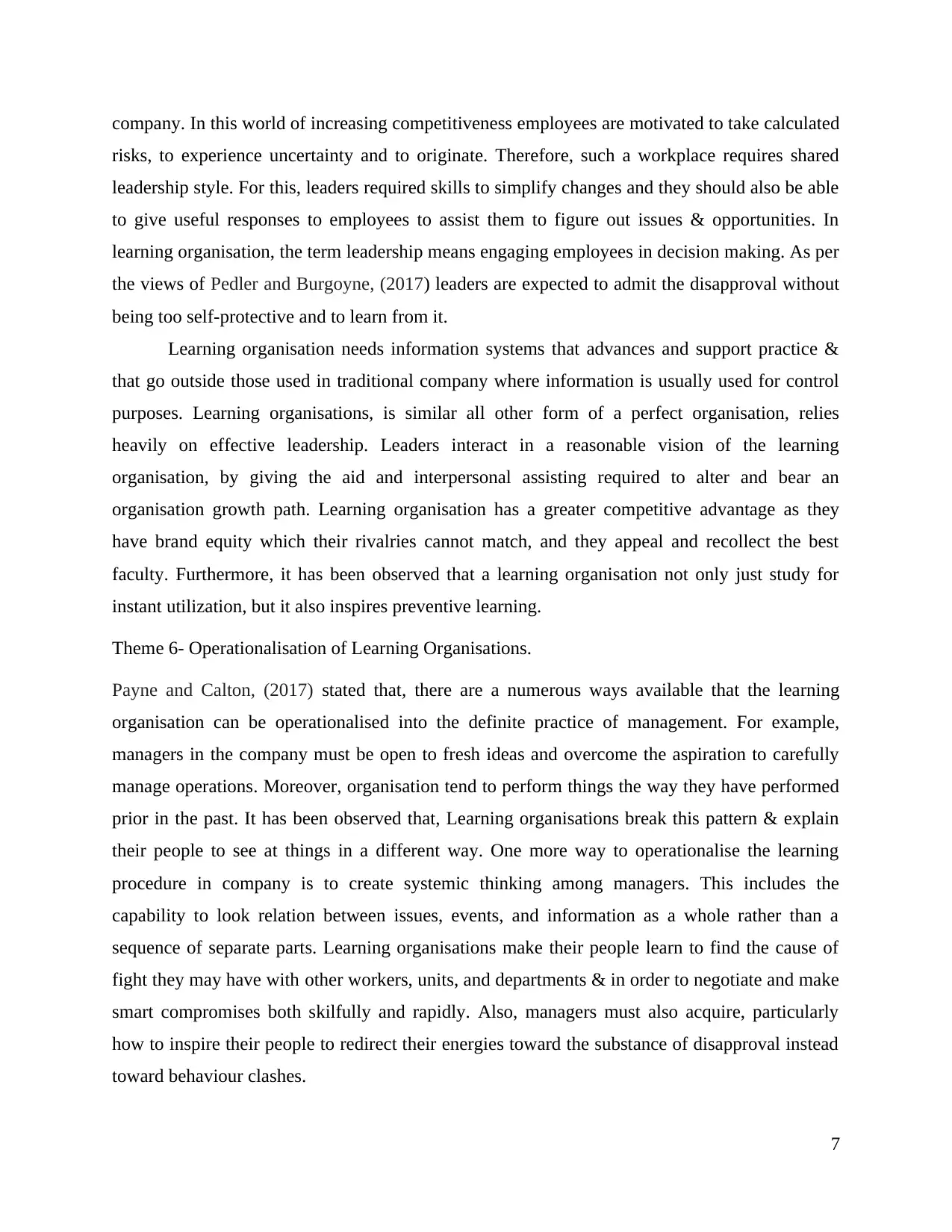
company. In this world of increasing competitiveness employees are motivated to take calculated
risks, to experience uncertainty and to originate. Therefore, such a workplace requires shared
leadership style. For this, leaders required skills to simplify changes and they should also be able
to give useful responses to employees to assist them to figure out issues & opportunities. In
learning organisation, the term leadership means engaging employees in decision making. As per
the views of Pedler and Burgoyne, (2017) leaders are expected to admit the disapproval without
being too self-protective and to learn from it.
Learning organisation needs information systems that advances and support practice &
that go outside those used in traditional company where information is usually used for control
purposes. Learning organisations, is similar all other form of a perfect organisation, relies
heavily on effective leadership. Leaders interact in a reasonable vision of the learning
organisation, by giving the aid and interpersonal assisting required to alter and bear an
organisation growth path. Learning organisation has a greater competitive advantage as they
have brand equity which their rivalries cannot match, and they appeal and recollect the best
faculty. Furthermore, it has been observed that a learning organisation not only just study for
instant utilization, but it also inspires preventive learning.
Theme 6- Operationalisation of Learning Organisations.
Payne and Calton, (2017) stated that, there are a numerous ways available that the learning
organisation can be operationalised into the definite practice of management. For example,
managers in the company must be open to fresh ideas and overcome the aspiration to carefully
manage operations. Moreover, organisation tend to perform things the way they have performed
prior in the past. It has been observed that, Learning organisations break this pattern & explain
their people to see at things in a different way. One more way to operationalise the learning
procedure in company is to create systemic thinking among managers. This includes the
capability to look relation between issues, events, and information as a whole rather than a
sequence of separate parts. Learning organisations make their people learn to find the cause of
fight they may have with other workers, units, and departments & in order to negotiate and make
smart compromises both skilfully and rapidly. Also, managers must also acquire, particularly
how to inspire their people to redirect their energies toward the substance of disapproval instead
toward behaviour clashes.
7
risks, to experience uncertainty and to originate. Therefore, such a workplace requires shared
leadership style. For this, leaders required skills to simplify changes and they should also be able
to give useful responses to employees to assist them to figure out issues & opportunities. In
learning organisation, the term leadership means engaging employees in decision making. As per
the views of Pedler and Burgoyne, (2017) leaders are expected to admit the disapproval without
being too self-protective and to learn from it.
Learning organisation needs information systems that advances and support practice &
that go outside those used in traditional company where information is usually used for control
purposes. Learning organisations, is similar all other form of a perfect organisation, relies
heavily on effective leadership. Leaders interact in a reasonable vision of the learning
organisation, by giving the aid and interpersonal assisting required to alter and bear an
organisation growth path. Learning organisation has a greater competitive advantage as they
have brand equity which their rivalries cannot match, and they appeal and recollect the best
faculty. Furthermore, it has been observed that a learning organisation not only just study for
instant utilization, but it also inspires preventive learning.
Theme 6- Operationalisation of Learning Organisations.
Payne and Calton, (2017) stated that, there are a numerous ways available that the learning
organisation can be operationalised into the definite practice of management. For example,
managers in the company must be open to fresh ideas and overcome the aspiration to carefully
manage operations. Moreover, organisation tend to perform things the way they have performed
prior in the past. It has been observed that, Learning organisations break this pattern & explain
their people to see at things in a different way. One more way to operationalise the learning
procedure in company is to create systemic thinking among managers. This includes the
capability to look relation between issues, events, and information as a whole rather than a
sequence of separate parts. Learning organisations make their people learn to find the cause of
fight they may have with other workers, units, and departments & in order to negotiate and make
smart compromises both skilfully and rapidly. Also, managers must also acquire, particularly
how to inspire their people to redirect their energies toward the substance of disapproval instead
toward behaviour clashes.
7
⊘ This is a preview!⊘
Do you want full access?
Subscribe today to unlock all pages.

Trusted by 1+ million students worldwide
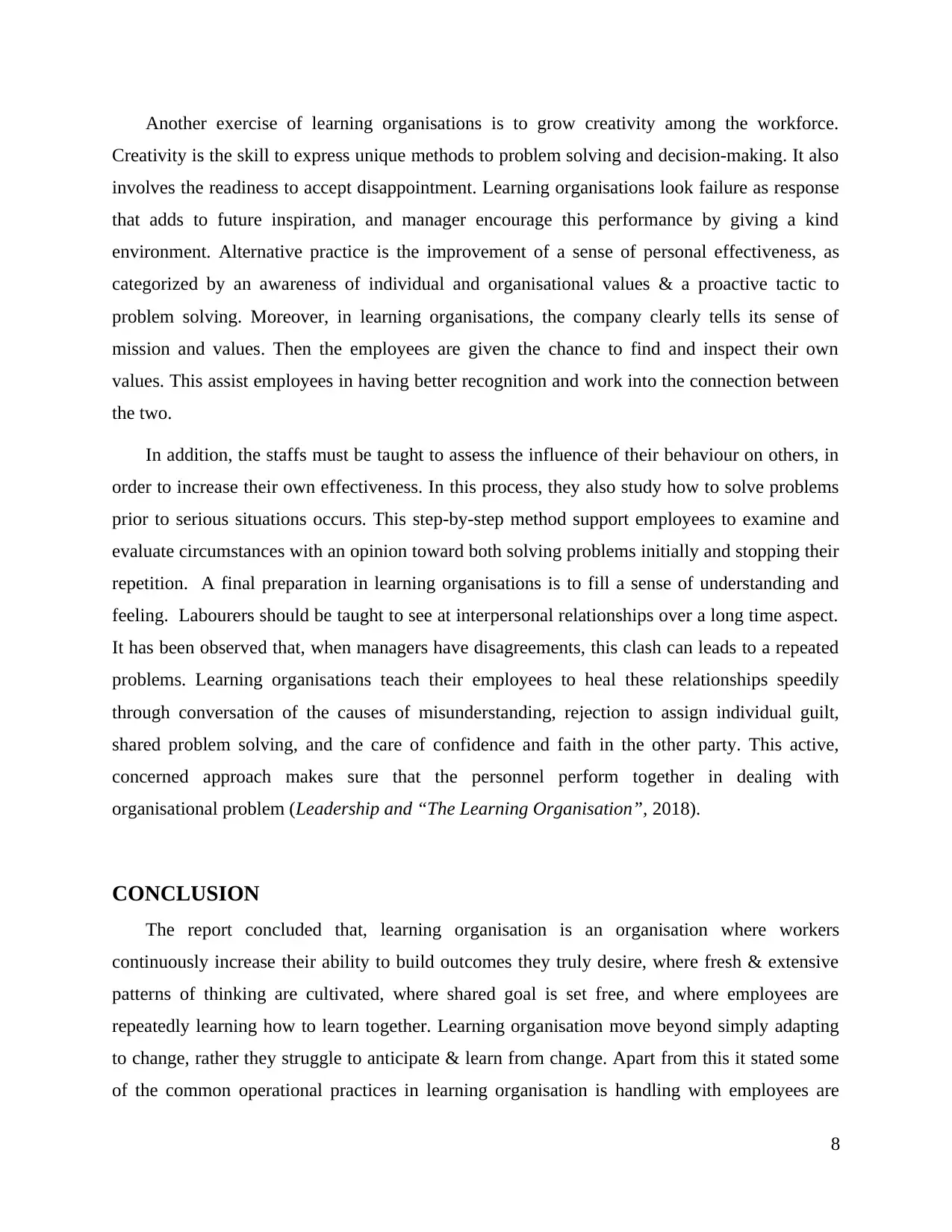
Another exercise of learning organisations is to grow creativity among the workforce.
Creativity is the skill to express unique methods to problem solving and decision-making. It also
involves the readiness to accept disappointment. Learning organisations look failure as response
that adds to future inspiration, and manager encourage this performance by giving a kind
environment. Alternative practice is the improvement of a sense of personal effectiveness, as
categorized by an awareness of individual and organisational values & a proactive tactic to
problem solving. Moreover, in learning organisations, the company clearly tells its sense of
mission and values. Then the employees are given the chance to find and inspect their own
values. This assist employees in having better recognition and work into the connection between
the two.
In addition, the staffs must be taught to assess the influence of their behaviour on others, in
order to increase their own effectiveness. In this process, they also study how to solve problems
prior to serious situations occurs. This step-by-step method support employees to examine and
evaluate circumstances with an opinion toward both solving problems initially and stopping their
repetition. A final preparation in learning organisations is to fill a sense of understanding and
feeling. Labourers should be taught to see at interpersonal relationships over a long time aspect.
It has been observed that, when managers have disagreements, this clash can leads to a repeated
problems. Learning organisations teach their employees to heal these relationships speedily
through conversation of the causes of misunderstanding, rejection to assign individual guilt,
shared problem solving, and the care of confidence and faith in the other party. This active,
concerned approach makes sure that the personnel perform together in dealing with
organisational problem (Leadership and “The Learning Organisation”, 2018).
CONCLUSION
The report concluded that, learning organisation is an organisation where workers
continuously increase their ability to build outcomes they truly desire, where fresh & extensive
patterns of thinking are cultivated, where shared goal is set free, and where employees are
repeatedly learning how to learn together. Learning organisation move beyond simply adapting
to change, rather they struggle to anticipate & learn from change. Apart from this it stated some
of the common operational practices in learning organisation is handling with employees are
8
Creativity is the skill to express unique methods to problem solving and decision-making. It also
involves the readiness to accept disappointment. Learning organisations look failure as response
that adds to future inspiration, and manager encourage this performance by giving a kind
environment. Alternative practice is the improvement of a sense of personal effectiveness, as
categorized by an awareness of individual and organisational values & a proactive tactic to
problem solving. Moreover, in learning organisations, the company clearly tells its sense of
mission and values. Then the employees are given the chance to find and inspect their own
values. This assist employees in having better recognition and work into the connection between
the two.
In addition, the staffs must be taught to assess the influence of their behaviour on others, in
order to increase their own effectiveness. In this process, they also study how to solve problems
prior to serious situations occurs. This step-by-step method support employees to examine and
evaluate circumstances with an opinion toward both solving problems initially and stopping their
repetition. A final preparation in learning organisations is to fill a sense of understanding and
feeling. Labourers should be taught to see at interpersonal relationships over a long time aspect.
It has been observed that, when managers have disagreements, this clash can leads to a repeated
problems. Learning organisations teach their employees to heal these relationships speedily
through conversation of the causes of misunderstanding, rejection to assign individual guilt,
shared problem solving, and the care of confidence and faith in the other party. This active,
concerned approach makes sure that the personnel perform together in dealing with
organisational problem (Leadership and “The Learning Organisation”, 2018).
CONCLUSION
The report concluded that, learning organisation is an organisation where workers
continuously increase their ability to build outcomes they truly desire, where fresh & extensive
patterns of thinking are cultivated, where shared goal is set free, and where employees are
repeatedly learning how to learn together. Learning organisation move beyond simply adapting
to change, rather they struggle to anticipate & learn from change. Apart from this it stated some
of the common operational practices in learning organisation is handling with employees are
8
Paraphrase This Document
Need a fresh take? Get an instant paraphrase of this document with our AI Paraphraser
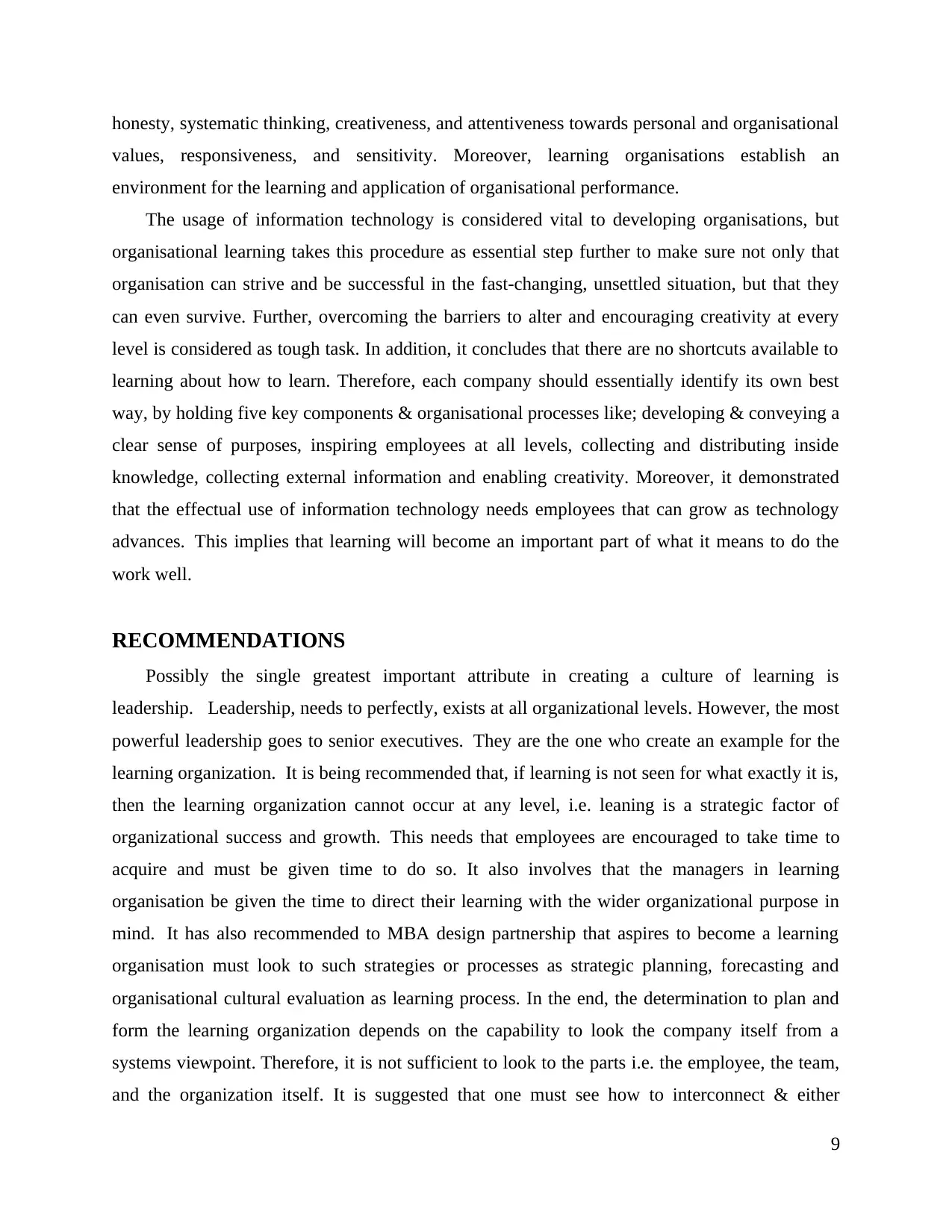
honesty, systematic thinking, creativeness, and attentiveness towards personal and organisational
values, responsiveness, and sensitivity. Moreover, learning organisations establish an
environment for the learning and application of organisational performance.
The usage of information technology is considered vital to developing organisations, but
organisational learning takes this procedure as essential step further to make sure not only that
organisation can strive and be successful in the fast-changing, unsettled situation, but that they
can even survive. Further, overcoming the barriers to alter and encouraging creativity at every
level is considered as tough task. In addition, it concludes that there are no shortcuts available to
learning about how to learn. Therefore, each company should essentially identify its own best
way, by holding five key components & organisational processes like; developing & conveying a
clear sense of purposes, inspiring employees at all levels, collecting and distributing inside
knowledge, collecting external information and enabling creativity. Moreover, it demonstrated
that the effectual use of information technology needs employees that can grow as technology
advances. This implies that learning will become an important part of what it means to do the
work well.
RECOMMENDATIONS
Possibly the single greatest important attribute in creating a culture of learning is
leadership. Leadership, needs to perfectly, exists at all organizational levels. However, the most
powerful leadership goes to senior executives. They are the one who create an example for the
learning organization. It is being recommended that, if learning is not seen for what exactly it is,
then the learning organization cannot occur at any level, i.e. leaning is a strategic factor of
organizational success and growth. This needs that employees are encouraged to take time to
acquire and must be given time to do so. It also involves that the managers in learning
organisation be given the time to direct their learning with the wider organizational purpose in
mind. It has also recommended to MBA design partnership that aspires to become a learning
organisation must look to such strategies or processes as strategic planning, forecasting and
organisational cultural evaluation as learning process. In the end, the determination to plan and
form the learning organization depends on the capability to look the company itself from a
systems viewpoint. Therefore, it is not sufficient to look to the parts i.e. the employee, the team,
and the organization itself. It is suggested that one must see how to interconnect & either
9
values, responsiveness, and sensitivity. Moreover, learning organisations establish an
environment for the learning and application of organisational performance.
The usage of information technology is considered vital to developing organisations, but
organisational learning takes this procedure as essential step further to make sure not only that
organisation can strive and be successful in the fast-changing, unsettled situation, but that they
can even survive. Further, overcoming the barriers to alter and encouraging creativity at every
level is considered as tough task. In addition, it concludes that there are no shortcuts available to
learning about how to learn. Therefore, each company should essentially identify its own best
way, by holding five key components & organisational processes like; developing & conveying a
clear sense of purposes, inspiring employees at all levels, collecting and distributing inside
knowledge, collecting external information and enabling creativity. Moreover, it demonstrated
that the effectual use of information technology needs employees that can grow as technology
advances. This implies that learning will become an important part of what it means to do the
work well.
RECOMMENDATIONS
Possibly the single greatest important attribute in creating a culture of learning is
leadership. Leadership, needs to perfectly, exists at all organizational levels. However, the most
powerful leadership goes to senior executives. They are the one who create an example for the
learning organization. It is being recommended that, if learning is not seen for what exactly it is,
then the learning organization cannot occur at any level, i.e. leaning is a strategic factor of
organizational success and growth. This needs that employees are encouraged to take time to
acquire and must be given time to do so. It also involves that the managers in learning
organisation be given the time to direct their learning with the wider organizational purpose in
mind. It has also recommended to MBA design partnership that aspires to become a learning
organisation must look to such strategies or processes as strategic planning, forecasting and
organisational cultural evaluation as learning process. In the end, the determination to plan and
form the learning organization depends on the capability to look the company itself from a
systems viewpoint. Therefore, it is not sufficient to look to the parts i.e. the employee, the team,
and the organization itself. It is suggested that one must see how to interconnect & either
9

become an effective as a whole. Hence, the learning organization is all about viewing outside
and inside as sources of knowledge.
10
and inside as sources of knowledge.
10
⊘ This is a preview!⊘
Do you want full access?
Subscribe today to unlock all pages.

Trusted by 1+ million students worldwide
1 out of 14
Related Documents
Your All-in-One AI-Powered Toolkit for Academic Success.
+13062052269
info@desklib.com
Available 24*7 on WhatsApp / Email
![[object Object]](/_next/static/media/star-bottom.7253800d.svg)
Unlock your academic potential
Copyright © 2020–2025 A2Z Services. All Rights Reserved. Developed and managed by ZUCOL.





